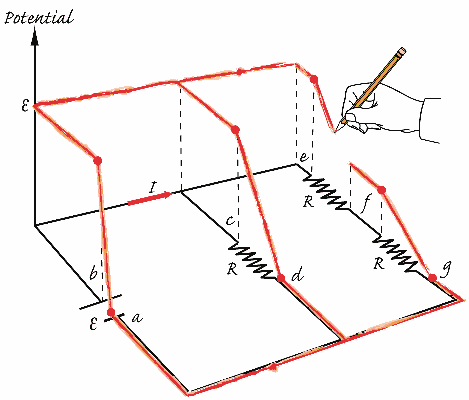Summary
- Electric potential
- Point charges
- Capacitance
Today's joke
- Written Quiz Ch. 19
Timer
Chapter 21


- Electric current
- Electrical resistance
- Resistivity
Example #1
- Ohm's law applet
Example #2
Example #3

- Lecture learning outcomes
A student who masters the topics in this lecture will be able to:
- describe the concept of electric current and the unit of an ampere
- describe resistance to the flow of current in terms of the resistivity of the material
- use algebra to find the resistance R, resistivity ρ, length L, or cross-sectional area A when any three of these quantities are given
- use algebra to find the potential difference ΔV, current I, or the resistance R when any two of these quantities are given
Practice:
Try these additional examples
Example #4
Example #5
Prepare:
Read textbook sections 21-3 through 21-4 before the next lecture
sj6 27.16
A 2.0-m-long, 0.012-m-radius wire carries 3.00 A of current driven by ΔV = 240 V. What is the resistivity of the conductor?
A. 80.0 Ω·m
B. 3.54×105 Ω·m
C. 0.112 Ω·m
D. 0.0181 Ω·m
Answer
kw4
If a 6-V battery provides 0.25 A of current to a light bulb, what is the resistance of the light bulb?
A. 0.042 Ω
B. 1.5 Ω
C. 6.0 Ω
D. 24 Ω
Answer
kw4
A 100-Ω resistor is attached to a 3-V battery. How much current will flow through the circuit?
A. 30 mA
B. 3.0 A
C. 33 A
D. 300 A
Answer
Walker5e 21.21

A potential difference V is applied to a conducting block of height A, width B,
and length C as shown above. Current IAB flows when V
is applied to the faces AB. What is the current when V is applied to the faces BC?
A. (AB/BC)IAB
B. (A²B²C²)IAB
C. (C²/A²)IAB
D. IAB
Answer
Walker5e EYU 21.2
If the voltage and resistance are each doubled in a simple battery-resistor circuit, the current will _____.
A. double
B. stay the same
C. be cut in half
D. be cut to a fourth
Answer
D. 0.0181 Ω·m

D. 24 Ω

A. 30 mA

C. (C²/A²)IAB

B. stay the same
You can support this answer algebraically with I = ΔV/R, or by remembering the potential difference drives the current and the resistance impedes the current. If both the driving force and impedance increase by the same amount, there will be no change in the current.









